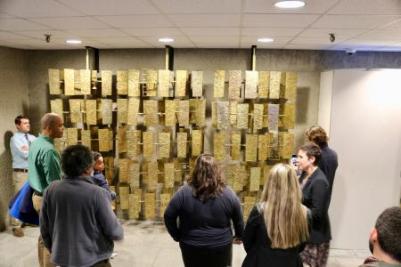From IBM to Yale: The Story Behind the Becton Center Sculpture

Perhaps you’ve passed by the bronze-colored sculpture in the Becton Center, but have ever really looked at it? As in, have you noticed certain discrepancies that break up the sculpture’s symmetry? Or considered the tension between its modular units and the expressive, improvisational surface textures?
 Folks from SEAS and the Yale School of Art recently did just that, meeting for a heady art-and-engineering discussion about this sculpture that has graced the halls of the Becton for more than four decades. On hand to lead the discussion were Sydney Simon, Bradley Assistant Curator for Academic Affairs, and Katherine Schilling, Associate Research Scientist in Chemical and Environmental Engineering.
Folks from SEAS and the Yale School of Art recently did just that, meeting for a heady art-and-engineering discussion about this sculpture that has graced the halls of the Becton for more than four decades. On hand to lead the discussion were Sydney Simon, Bradley Assistant Curator for Academic Affairs, and Katherine Schilling, Associate Research Scientist in Chemical and Environmental Engineering.
It turns out that this mid-century modern piece, titled Sculptural Screen, has a rich history and occupies a unique place in art. Created by artist Harry Bertoia in 1958, it was commissioned by IBM for its midtown Manhattan office tower. By 1966, IBM decided it couldn’t find a proper place for it and contacted Yale about a “long-term loan.” The piece was installed in 1975 and it’s been here ever since.
The sculpture is probably made of steel and brazed - coated in molten metal - with copper and other metals. Simon noted that, in this case, it “creates a remakarble range of expressive colors and textures on its surface.”
The piece was made during Bertoia’s period of making sculptures that serve both aesthetic and functional purposes. His sculptures, like the one in Becton, were often used to divide open spaces. He usually worked with architects as they were designing the building - that way, he could “do something of the moment, which allows him to think about how the sculpture would relate to its space.” Bertoia, who died in 1978, had a varied career. His early success in designing furniture with an artistic/architectural style afforded him the opportunity to take on more experimental projects. Late in his career, he helped pioneer the field of sound sculpture.
As it is in the Becton Center, Sculptural Screen took on a new life thanks to its surroundings. Simon pointed to the three video monitors flashing SEAS news that face directly opposite the Bertoia, and called it a “sort of screen faceoff.”
Schilling took a chemical engineer’s eye to the piece and pointed to some of her favorite examples of deterioration, including a greenish patch of copper (II) chloride. For the most part, though, the sculpture’s in good shape. And Schilling also noted that “deterioration” is different from “damage” in that it’s a natural part of an artwork’s aging process, and really not such a bad thing.
“Time keeps going and these processes are what gets studied here in Engineering,” she said.

